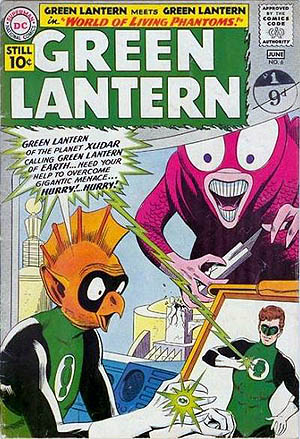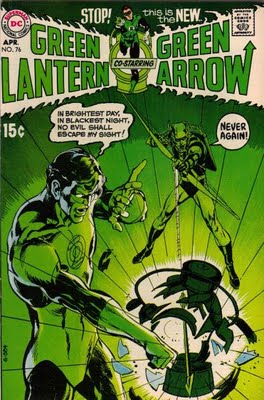So I finally got around to seeing the 2011 film version of Green Lantern. The movie was generally panned by critics and audiences alike, but I felt that I owed it to myself to see if it was really that bad.
First, the stuff I liked.
Taika Waititi as Tom Kalmaku was great. I was wondering how or if the film was going to include Hal's best friend "Pieface." OK, Tom was introduced in 1960 when (white) people didn't consider it racist to call the Inuit people "Eskimos" or to refer to an Inuit native as "Pieface." Pie, uh...Tom was originally Hal's aircraft mechanic at Ferris Aircraft and Hal's best friend (on earth) but he got an upgrade to best friend and engineer. In the silver age GL comics, Tom actually chronicled Hal's adventures (that book would be worth a lot of money) not unlike Dr. Watson's role relative to the adventures of Sherlock Holmes. Sometimes, the reader is treated to a GL adventure from Tom's POV.
In the film, Tom is a fun and smart engineer who can readily out think Hal but who still makes for a good "wingman" and reminder of just what an irresponsible jerk Hal can be sometimes.
Peter Sarsgaard in the role of Hector Hammond pre-transformation. He was brilliant, quirky, but likable and approachable. In spite of his intelligence, he was vulnerable and always living in the shadow of his powerful Senator father. If "Daddy Dearest" had just left him alone and kept him out of the investigation into Abin Sur and his spaceship, Hector would have gotten along just fine. It kind of ruinned it when the Parallax fear energy started infecting him, resulting in him murdering his own father (the guy was a douche, but not worth an execution by fire douche) and committing other heinous crimes including turning the earth over to a superpowerful alien (the aforementioned Parallex) for destruction.
Blake Lively as Carol Ferris. I thought she struck the right balance between corporate responsibility and human vulnerability, the heir apparent of the Ferris Aircraft "empire." She could be a little too "dippy" at times, especially for a woman who knows how to handle all of that responsibility, but in the end, she managed to keep her head long enough to save Hal from Parallex's clutches so he could retrieve his ring and save the day.
I was a little disappointed that the writers made her a test pilot and a corporate executive, not because I have anything against women being test pilots, but Carol was always the yang to Hal's yin, the level headed responsible person to Hal's irresponsible adventurer. Putting them both in high performance aircraft and literally making her Hal's wingman crossed the line and disrupted the balance between their characters. Carol and Hal shouldn't be on the same playing field.
I'm glad the movie maintained Hal's family including his brothers and nephew. The silver age GL comics always made a point to show Hal and his brothers together, each one having their own skill sets and all of them being highly competitive as brothers. It humanized Hal for the readers in a way the "only children" heroes of the 1960s (Superman, Batman, Flash, and so on) never did. In real life, most of us have some sort of family.
The scene between Hal and his young nephew Jason was one of the better ones in the film. Hal, the fun, favorite uncle, who screwed up and almost got himself killed, freaking out young Jason, not unlike how Hal felt the day he watched his father die as a test pilot in an experimental jet.
The portrayals of Sinestro (Mark Strong), Tomar-Re (Geoffrey Rush), and Kilowog (Michael Clarke Duncan) were great. Although the dedication and heroism of Sinestro was an especially strong presence in the film (foreshadowing Sinestro's fall from grace later on), Rush's Tomar-Re was my favorite among the "alien" GL's. As a kid, Tomar-Re was my favorite GL after Hal. He was Hal's best friend in the Corps in the silver age comics. Although the DC writers may not have intended it, the friendship between Hal Jordan and Tomar-Re showed that no matter how different, how alien two intelligent, compassionate beings can be, it's the desire to do good and to uphold justice that beings us together. Fitting that their relationship should have started during the early civil rights era.
In the film, Rush lends a calmness and warmth to Tomar-Re's voice. You can trust him. He's a little bemused at Hal pretty much all the time, but it's like a father relating to a young child who knows one day that child will grow to far surpass him. Tomar-Re is the kind of friend (and father figure) who would give a son just the right amount of encouragement and the time it takes for Hal to grow up.
What didn't I like.
Everything else.
From the first few moments of the film and the opening narration, I could tell I was going to be disappointed. It was like reading a comic book and not a particularly well written one. The opening just screamed at me: "Don't take this film seriously." In relation to the Dark Knight Trilogy and the soon to be released film Man of Steel (the trailers look fabulous), Green Lantern was nothing to write home about.
I think Ryan Reynolds was well cast to play the version of Hal Jordan the writers created, but he wasn't the Hal Jordan. In the original comic books, Hal already had the heart of a warrior and a hero. He had the personality of a policeman, albeit a somewhat rigid one. Right and wrong were polar opposites and in his heart, he always knew the difference, a fact that writer Dennis O'Neal used to good advantage when he and artist Neal Adams created the now legendary story No Evil Shall Escape My Sight (Green Lantern #76 - 1970).
Of course "perfect" heroes, such as DC tended to create in the 1950s and 60s don't make good movie characters because they have no room to grow. But having grown up loving the Hal Jordan Green Lantern and wishing for a really good film version of my favorite DC hero, I just didn't "feel it" watching Reynolds play Hal on the screen.
Frankly, I think the film's approach was all wrong. I'd never have introduced the "outer space" aspects of what it is to be a Green Lantern and certainly wouldn't have introduced the Corps and the Guardians so early in the game.
Hal had virtually no time to come to terms with the ring and the lantern before being whisked away to Oa, and even then, his training was about fifteen minutes long before Hal "quit," took the power ring, and with his tail tucked between his legs, scurried back to earth.
In the early silver age comics, Hal didn't know anything about the Corps. He periodically got "orders" from the lantern about specific "assignments" but he didn't know where they came from or what they meant beyond the immediate mission. I would have liked to have seen Hal trying to deal with the ring and the lantern more on his own first, discovering himself as a hero but only beginning to get a glimpse at the true implications of wielding that kind of power.
The writers could have even introduced a sort of "symbiotic" relationship between Hal and the ring, as if they both had something to give each other, the ring giving Hal power and Hal giving the ring the means to use it for good.
In spite of the fact that Hal was given a virtually overwhelming villain to defeat and the task of protecting the planet earth, I just didn't get any sort of personal angst or anguish...something to really overcome. Sure, Hector Hammond captured Carol and threatened to infect her with the Parallax energy, but I was really hoping Hal would have been able to face something even more personal (or maybe it was just the writing and the performances that didn't convey what I was looking for).
I recall in the issue 34 (1966) Green Lantern story "End of a Gladiator," Hal learned about the ring's "mortality fail safe." An emergency store of energy that's available, even when the ring's energy charge is exhausted, that can save a Green Lantern's life, even when the ring wielder is unconscious. During a battle between GL and one of his foes, Tom is mortally wounded. The villain tricked Green Lantern into thinking he had recently charged his ring, but in fact, it was an illusion and at the height of the battle, Hal's ring runs out of power. On the one hand, Hal is about to be shot. If he does nothing, the ring's emergency reserve will save his life. On the other hand, Tom is seconds from death. Hal does the impossible and orders the ring to use the emergency reserve to save Tom's life. Tom lives, but Hal is shot and presumed dead (a highly unusual set of circumstances results in his being revived).
It's that kind of conflict that would have made the climax of the film. The stakes didn't have to be a world, just the struggle for discovery of how heroic, how courageous, how honest Green Lantern member Hal Jordan could be.
In spite of all the special effects, the best efforts of the actors involved, and the decades of source material to be drawn from, Green Lantern the legendary hero of my childhood never materialized on the screen in 2011. It was just another movie.
With the potential for a DC Universe set of films culminating in one or more JLA movies in the future, I'm hoping for a Green Lantern reboot. Let's do it better next time.
Saturday, June 8, 2013
DVD Review: Green Lantern (2011)
Labels:
2011,
DC,
DC comics,
DVD review,
film review,
green lantern
Subscribe to:
Post Comments (Atom)






No comments:
Post a Comment